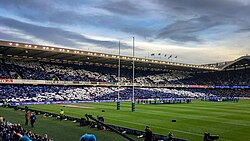 | |
 Front facade of Murrayfield Stadium, 2018 | |
 Interactive map of Murrayfield Stadium | |
| Location | Roseburn Street Edinburgh EH12 5PJ |
|---|---|
| Public transit | |
| Owner | Scottish Rugby Union |
| Operator | Scottish Rugby Union |
| Capacity | 67,144 |
| Record attendance | 104,000 (1975 Five Nations – Scotland vs Wales) |
| Surface | Desso GrassMaster hybrid pitch |
| Construction | |
| Opened | 21 March 1925 |
| Renovated | 1995 |
| Tenants | |
| Scotland national rugby union team (1925–present) Edinburgh Rugby (1996–2017, 2018–present selected matches) Edinburgh Sevens (2007–2011) Scottish Claymores (1995–2002) | |
Murrayfield Stadium is a rugby union stadium located in the Murrayfield area of Edinburgh, Scotland. The stadium is owned by the Scottish Rugby Union (SRU) who has its headquarters based at the stadium, and is the national stadium of the Scotland national rugby union team. With a seating capacity of 67,144, it is the largest stadium in Scotland, the fifth largest in the United Kingdom, and the twenty-second largest in Europe. [1]
Contents
- History
- Purchase of land
- Usage during WWII
- Recent history
- Location
- Transport
- Buses
- Rail
- Tram
- Rugby union
- Rugby World Cup
- Rugby league
- Other sports
- Association football
- American football
- Music
- See also
- References
- External links
It officially opened on 21 March 1925 with a game between Scotland and England. [2] The game was won by Scotland who came out victorious following a Grand Slam. [3] The stadium hosts most of Scotland's home test matches and the Scottish Hydro Electric Cup final, as well as URC and European Rugby Champions Cup matches.
Although primarily a rugby union stadium, Murrayfield has in the past hosted American football, rugby league and association football matches, as well as numerous music concerts. Currently, the stadium is known as Scottish Gas Murrayfield Stadium for sponsorship reasons.






